#hakuto-r lunar lander
Text

The moon casts a shadow over Australia during a total solar eclipse, as the Earth rises over the moon's horizon. Days before Japan's Hakuto-R lunar lander crashed into the moon's surface on April 25, 2023, it snapped this gorgeous picture of our planet.
(Image credit: ispace)
#ispace#photographer#moon#earth#space#astronomy#science#australia#total solar eclipse#japan#hakuto-r lunar lander#nature
32 notes
·
View notes
Text
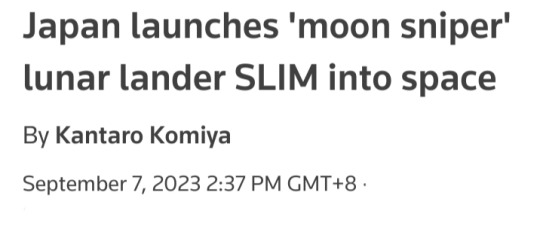

TOKYO, Sept 7 (Reuters) - Japan launched its lunar exploration spacecraft on Thursday aboard a homegrown H-IIA rocket, hoping to become the world's fifth country to land on the moon early next year.
Japan Aerospace Exploration Agency (JAXA) said the rocket took off from Tanegashima Space Center in southern Japan as planned and successfully released the Smart Lander for Investigating Moon (SLIM).
Unfavourable weather led to three postponements in a week last month.
Dubbed the "moon sniper," Japan aims to land SLIM within 100 metres of its target site on the lunar surface.
The $100-million mission is expected to start the landing by February after a long, fuel-efficient approach trajectory.
"The big objective of SLIM is to prove the high-accuracy landing ... to achieve 'landing where we want' on the lunar surface, rather than 'landing where we can'," JAXA President Hiroshi Yamakawa told a news conference.

The launch comes two weeks after India became the fourth nation to successfully land a spacecraft on the moon with its Chandrayaan-3 mission to the unexplored lunar south pole.
Around the same time, Russia's Luna-25 lander crashed while approaching the moon.
Two earlier lunar landing attempts by Japan failed in the last year.
JAXA lost contact with the OMOTENASHI lander and scrubbed an attempted landing in November.
The Hakuto-R Mission 1 lander, made by Japanese startup ispace (9348.T), crashed in April as it attempted to descend to the lunar surface.
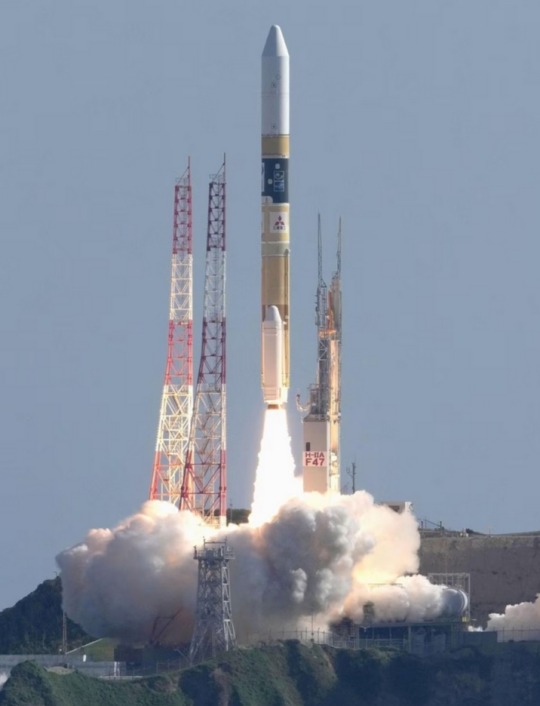
SLIM is set to touch down on the near side of the moon close to Mare Nectaris, a lunar sea that, viewed from Earth, appears as a dark spot.
Its primary goal is to test advanced optical and image processing technology.
After landing, the craft aims to analyse the composition of olivine rocks near the sites in search of clues about the origin of the moon. No lunar rover is loaded on SLIM.
Thursday's H-IIA rocket also carried the X-Ray Imaging and Spectroscopy Mission (XRISM) satellite, a joint project of JAXA, NASA and the European Space Agency.
The satellite aims to observe plasma winds flowing through the universe that scientists see as key to helping understand the evolution of stars and galaxies.

Mitsubishi Heavy Industries (7011.T) manufactured the rocket and operated the launch, which marked the 47th H-IIA rocket Japan has launched since 2001, bringing the vehicle's success rate close to 98%.
JAXA had suspended the launch of H-IIA carrying SLIM for several months while it investigated the failure of its new medium-lift H3 rocket during its debut in March.
Japan's space missions have faced other recent setbacks, with the launch failure of the Epsilon small rocket in October 2022, followed by an engine explosion during a test in July.
The country aims to send an astronaut to the moon's surface in the latter half of the 2020s as part of NASA's Artemis programme.
https://www.reuters.com/technology/space/japan-launches-rocket-carrying-moon-lander-slim-after-three-delays-2023-09-06/
youtube
Japan launches 'Moon Sniper' mission | AFP
7 September 2023
Japan's "Moon Sniper" mission blasted off Thursday as the country's space programme looks to bounce back from a string of recent mishaps, weeks after India's historic lunar triumph.
#H-IIA rocket#Japan#lunar exploration spacecraft#SLIM#moon sniper#Japan Aerospace Exploration Agency (JAXA)#Tanegashima Space Center#Smart Lander for Investigating Moon#Hiroshi Yamakawa#Hakuto-R Mission 1 lander#ispace#Mare Nectaris#X-Ray Imaging and Spectroscopy Mission (XRISM) satellite#JAXA#NASA#European Space Agency#Mitsubishi Heavy Industries#Artemis#space#space rocket#Youtube#Chandrayaan-3 mission#Luna-25 lander#India#Russia#moon#moon landing
22 notes
·
View notes
Video

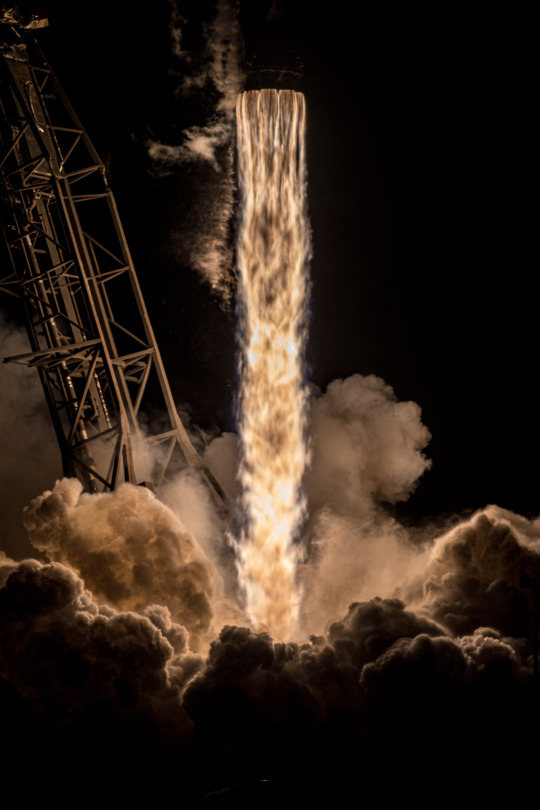


SpaceX Falcon 9 Delivers 5-Ton Communications Satellite to Orbit
The company continues to launch rockets at a breakneck pace, with 16 flights of Falcon 9 in the past nine weeks alone.
A Falcon 9 lit up the Florida skies Monday night in what is now a very familiar scene. The rocket successfully deployed Hispasat’s Amazonas Nexus communications satellite into a trajectory that will take it to a geostationary orbit, from where it will expand the Spanish company’s coverage across the Americas, the Atlantic Ocean, and Greenland.
The rocket took flight at 8:32 p.m. ET from Space Launch Complex 40 at Cape Canaveral Space Force Station in Florida. Some eight minutes later, the main stage booster, B1073-6, performed a successful vertical landing atop the Just Read the Instructions droneship stationed in the Atlantic Ocean. This was the booster’s sixth flight, having previously delivered the SES-22 satellite, ispace’s HAKUTO-R lunar lander, and three batches of the company’s Starlink satellites.
#SpaceX#SpaceX Falcon 9 Delivers 5-Ton Communications Satellite to Orbit#Hispasat’s Amazonas Nexus communications satellite#space#spaceship#solar system#earth orbit#cape canaveral#elon musk
15 notes
·
View notes
Photo

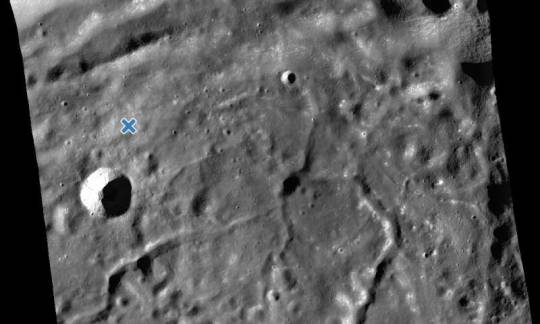

NASA's LRO views impact site of HAKUTO-R mission 1 moon lander The ispace HAKUTO-R Mission 1 lunar lander was launched on Dec. 11, 2022, a privately funded spacecraft planned to land on the lunar surface. After a several-month journey to the moon, the spacecraft started a controlled descent to the surface to land near Atlas crater. The ispace team announced the following day that an anomaly occurred, and the HAKUTO-R Mission 1 lunar lander had not safely touched down on the surface. HAKUTO-R Mission 1 lunar lander site, as seen by the Lunar Reconnaissance Orbiter Camera (LROC) on April 26, 2023, the day after the attempted landing. The scale bar is 100 m across. LROC NAC image M1437131607R. Credit: NASA’s Goddard Space Flight Center/Arizona State University The ispace HAKUTO-R Mission 1 lunar lander was launched on Dec. 11, 2022, a privately funded spacecraft planned to land on the lunar surface. After a several-month journey to the moon, the spacecraft started a controlled descent to the surface to land near Atlas crater. The ispace team announced the following day that an anomaly occurred, and the HAKUTO-R Mission 1 lunar lander had not safely touched down on the surface. On April 26, 2023, NASA's Lunar Reconnaissance Orbiter (LRO) spacecraft acquired 10 images around the landing site with its Narrow Angle Cameras. The images covered a region roughly 40 km by 45 km (about 25 miles by 28 miles). Using an image acquired before the landing attempt, the LRO Camera science team began searching for the lander. From the temporal image pair, the LRO Camera team identified an unusual surface change near the nominal landing site. The image shows at least four prominent pieces of debris and several small changes (47.581 degrees North latitude, 44.094 degrees East longitude). The central feature in the image above shows several bright pixels in the upper left and several dark pixels in the lower right. This is the opposite of nearby boulders, suggesting that this could be a small crater or different parts of the lander body. This site will be further analyzed over the coming months as LRO has the opportunity to make additional observations of the site under various lighting conditions and viewing angles. TOP IMAGE....HAKUTO-R Mission 1 lunar lander site, as seen by the Lunar Reconnaissance Orbiter Camera (LROC) on April 26, 2023, the day after the attempted landing. The scale bar is 100 m across. LROC NAC image M1437131607R. Credit: NASA’s Goddard Space Flight Center/Arizona State University CENTRE IMAGE....LROC Narrow Angle Camera mosaic of the HAKUTO-R Mission 1 lunar lander site made from the following image pairs: M1437138630L/R, 1437131607L/R, M1437124584L/R, 1437117561L/R, M1437110537L/R. Credit: NASA’s Goddard Space Flight Center/Arizona State University LOWER IMAGE....Ratio image created by dividing the after (M1437131607R) and before (M192675639R) images. The impact created an area of higher reflectance, approximately 60-80 m across. The scale bar in the lower right is 50m across. Credit: NASA’s Goddard Space Flight Center/Arizona State University
4 notes
·
View notes
Text
That's how I want to go out, taking a great picture just before doing so.
Not on the Moon, however, that would intimidate me.
3 notes
·
View notes
Link
The phrase “private Moon lander” elicits the response “what a time to be alive!”
Needless to say, we wish them every success.
2 notes
·
View notes
Link
Japan’s Smart Lander for Investigating Moon (SLIM) lunar lander appears to have achieved a soft touchdown on the Moon’s surface but is currently unable to generate electricity from onboard solar cells. With the spacecraft running only on internal battery power, controllers are working to balance the recording and downloading of data, utilizing the remaining battery life to maximum effect. The reason for the lack of electrical generation is not currently known, but officials report that the solar cells do not appear to be damaged and that all other systems are working as designed. There is some optimism that sunlight may reach the solar cells and recharge the batteries, but this is by no means guaranteed. The mission has been officially marked as reaching its minimum success levels at this time, subject to further data analysis. Four months after launching from Tanegashima Space Center, SLIM, led by the Japan Aerospace Exploration Agency (JAXA), made a landing near Shioli, an impact crater within the larger Mare Nectaris (“Sea of Nectar”) at 11:20 PM JST on Jan. 19, 2024 (15:20 UTC). SLIM has been on a unique voyage involving two close approaches to the Moon and orbits, which took it out into deep space, traveling for 110 days before making a lunar insertion burn on Christmas Day into a Lunar Orbit of 15 x 600 kilometers. Further burns have slowly lowered and circularised the orbit. The long looping trajectory was designed to save vital fuel and mass for the landing phase, giving the spacecraft the best possible chance for a soft landing. JAXA Update on SLIM: Lander did land, they have comms, but the solar cell is not generating electricity. On battery power. Trying to maximize science. LEV separated as planned but JAXA needs more time to gather data. https://t.co/4Wct726bum — Chris Bergin – NSF (@NASASpaceflight) January 19, 2024 Japan was hoping to join the small group of countries that have soft-landed on the Moon, along with Russia, the United States, China, and, more recently, India. Japan has had two previous attempts at landing on the Moon — Omotenashi and Hakuto-R — both of which failed. There have also been several other notable failed attempts at a Lunar landing in recent years: Omotenashi was a small 6u cubesat launched from Artemis 1, which had issues with solar cell orientation and was lost. Hakuto-R was a commercial lander designed by the Japanese company iSpace. This lander crashed into the Moon on April 25, 2023, following confusion between the various navigation systems leading to fuel exhaustion. Previously, in 2019, Israel’s Beresheet lander was another failure, crashing onto the Moon’s surface after a gyroscope failed, resulting in loss of control of the craft. More recently, the Astrobotic Peregrine One lunar lander was unable to attempt a Moon landing following an anomaly in the propulsion system, which, in turn, caused problems keeping the spacecraft in a Sun-facing orientation. Propellant leaking from the system added to the issues, ruling out any landing attempt. The leak slowed down as the days passed, which allowed controllers to concentrate on allowing Peregrine to complete as much science as possible. Astrobotic was able to maintain transparent and informative communication with the public throughout the mission. Controllers steered the lander carefully and responsibly to avoid creating any space debris, bringing it onto a course to intercept Earth’s atmosphere, where it burned up safely over the Pacific on Jan.18, 2024. SLIM’s primary mission was to demonstrate that advanced navigation and radar systems can provide a pinpoint landing within 100 meters of any given target. To achieve this vastly improved accuracy, the spacecraft carried several advanced instruments, including a laser range finder and a landing radar. During its descent to the lunar surface, the lander was able to compare the terrain below to high-resolution imagery gathered from Japan’s previous lunar orbiter, Kaguya, and NASA’s Lunar Reconnaissance Orbiter, to make autonomous real-time decisions about its speed and course using image processing algorithms developed by JAXA. Accurately targeted landings are seen as vital for ensuring optimum results from future landers, but the final position of this landing may not be known for some weeks, according to JAXA officials. The target for landing, the Shioli crater, is an impact crater about 300 meters wide and has important scientific potential, not least for the suspected presence of the mineral olivine, which is conjectured to comprise part of the Moon’s mantle. The near-infrared Multi-Band Camera aboard SLIM will determine the composition of olivine by analyzing the spectra of sunlight reflected off the lunar surface. The data will further inform scientists about the early formation of the Moon. See AlsoSLIM Mission UpdatesMore Japanese Missions CoverageNSF StoreClick here to Join L2 The second major objective for this mission is the “realization of a lightweight lunar and planetary probe system to allow more frequent lunar and planetary exploration missions.” To this end, SLIM has been through thoughtful weight reduction, using modern construction techniques, and a powerful chemical-based thruster system. The structural core of the spacecraft is the integrated fuel tank, a cylinder that holds both fuel and oxidizer using a common dome to save mass. The oxidizer portion has a specially developed form of Polytetrafluoroethylene lining to prevent reaction. There are two main engines, built by Mitsubishi Heavy Industries, Ltd. KYOCERA Corporation. These feature ceramic combustion chambers, a very wide thrust range, and can fire using advanced pulsing techniques to aid precision positioning. The engines each provide around 500 newtons of thrust and are used for the main insertion burns during transit to the Moon and the descent/landing burn. Thrusters used to provide attitude control were built by IHI AEROSPACE Co. Ltd. There are 12 of these thrusters, each with a thrust rating of around 20 newtons. They use the same fuel/oxidizer as the main engines to aid in the lightweight design by avoiding the need for additional fuel tanks. Graphic showing SLIM’s landing procedure. (Credit: JAXA) The solar panel arrays for SLIM are built by the SHARP Corporation and are made of thin, light, and flexible film. These are designed to bend around some of the curved surfaces of the craft and are attached simply with velcro in some places. SLIM was designed to land on a slope of approximately 15 degrees from the horizontal. As the spacecraft approached its landing with the main engines pointing downward to reduce the rate of descent, the thrusters were expected to tip the craft over to about 45 degrees, so that the main landing legs touch down first and then the craft completes the rotation into horizontal mode with the auxiliary legs touching down last. The legs all have a crush pad of 3D-printed aluminum alloy to absorb any impact stresses during touchdown. Just before landing, SLIM ejected two small automata Lunar Excursion Vehicles (LEV), LEV-1 and LEV-2. These will explore and photograph the surrounding environment and the lander, each utilizing novel experimental propulsion techniques. LEV-1 is designed to hop frog-like around the Lunar surface, not only taking photos but also measuring slope, elevation, temperature, and radiation of the local lunar environment. This rover is also capable of direct communication back to Earth. LEV-2 has been developed by JAXA in collaboration with Tomy, Sony, and Doshisha University, Japan. Weighing a mere 250 grams and only eight centimeters in diameter, this baseball-shaped vehicle has been inspired by co-developer Tomy’s Transformers toys. The initial design concept had to be reduced in size and weight to meet the limitations imposed by the mission’s lightweight ideals. On landing, the ball split apart to form two wheels and reveal pop-out cameras and a stabilizer. The method of forward movement, a waggling motion was inspired by that of the sea turtle. This collaboration with Tomy is intended to inspire children to dream big, and indeed a toy version of SORA-Q as LEV-2 is also known, is being sold in Japan. SLIM ejects two LEV’s onto the Moon. (Credit: JAXA) LEV-1 will beam data from both LEVs back to the Deep Space Network stations on Earth. Before the landing, the information available suggested that SLIM is a limited lifetime proof of concept lander, and was expected to function only until the Sun sets on the landing site after a maximum of 14 Earth days. At this point, the spacecraft would lose all power, and the electronics would likely be damaged by the extreme cold of the lunar night. However, since the issue with the electrical supply became known, the JAXA officials are suggesting that the lander could be put into sleep mode until the Sun lights the cells again. There has been an upturn in interest in landing on the Moon, and there are several more landing attempts due in the near future. NASA’s Commercial Lunar Payload Services (CLPS) is providing incentives for commercial partners to demonstrate reliable cargo delivery capabilities to support the Artemis mission. CLPS has already produced the Peregrine One mission, which has provided data, and experience and generated public interest despite its failure to land. Intuitive Machines is hoping to succeed with its first Moon landing attempt when its Nova-C lander launches as early as February 2024 on a SpaceX Falcon 9. Nova-C is described as being the size of a telephone box and carries 130 kilograms of payload, mostly instrumentation for NASA, but also a cubesat and a deployable camera called EagleCAM. Intuitive Machines has three missions for Nova-C under the CLPS contract. Japan has a second Hakuto-R mission planned for NET Q4 2024. This mission, named Resilience, will launch on a SpaceX Falcon 9 and will feature a micro-rover. (Lead image: Render of the SLIM Lander on the Moon. Credit: JAXA) The post Japan’s SLIM lands on the Moon, power issues cast doubt on lander’s survival appeared first on NASASpaceFlight.com.
0 notes
Text
0 notes
Text
NASA uncovers shattered remains of Japanese lunar lander that mysteriously disappeared on April 25
Japan's private Hakuto-R spacecraft broke into at least four large pieces of debris, according to new images from NASA's Lunar Reconnaissance Orbiter.
from Livescience https://www.livescience.com/space/the-moon/nasa-uncovers-shattered-remains-of-japanese-lunar-lander-that-mysteriously-disappeared-on-april-25
via IFTTT
0 notes
Text
NASA captured images of private Japanese moon lander's crash
NASA couldn’t help but do a little rubbernecking of the recent crash site where a private Japanese company recently attempted to land on the moon.
The Hakuto-R mission ended abruptly on April 25, 2023, shortly after ispace lost contact with its spacecraft as it descended toward the lunar surface. A preliminary investigation indicated the lander had run out of fuel, according to the company, which…

View On WordPress
0 notes
Text
Moon crash site found! NASA orbiter spots grave of private Japanese lander (photos)
Space.com
By Andrew Jones
May 23, 2023
A NASA lunar orbiter has spotted the final resting place of a private Japanese moon lander that failed in its touchdown attempt last month.
The Hakuto-R lander, also carrying a small rover for the United Arab Emirates, made its landing attempt on April 25, aiming to set down in Atlas Crater. However, communications with the lander were lost moments before…
View On WordPress
0 notes
Text

CNN — Japan’s “Moon Sniper” robotic explorer landed on the lunar surface, but the mission may end prematurely since the spacecraft’s solar cell is not generating electricity, the Japan Aerospace Exploration Agency said.
The agency said it is currently receiving a signal from the lander, which is communicating as expected.
The uncrewed Smart Lander for Investigating Moon, or SLIM, mission landed just after 10:20 a.m. ET Friday (12:20 a.m. Saturday Japan Standard Time), according to telemetry data shared on JAXA’s live broadcast.
Currently, the lander is operating on limited battery power, only expected to last several hours.
The JAXA team is analyzing the data to determine the cause of the solar cell issue and the next steps for the lander.
It’s possible that the solar cell issue is due to the fact that the spacecraft is not pointing in the intended direction, JAXA officials said.
There is hope that as the solar angle changes on the moon, the solar cell may be able to charge again, but that may take some time and will depend on whether SLIM can survive the frigid lunar night, the team shared during a news conference.
The agency believes the mission has met the criteria to declare it a “minimum success,” because the spacecraft achieved a precise and soft lunar landing using optical navigation.
The touchdown makes Japan the third country this century — and the fifth ever — to land on the moon.
When asked to score the landing operation for SLIM, JAXA director general Dr. Hitoshi Kuninaka gave it a “60 out of 100,” while also mentioning that he is known for making “harsh comments.”
The team is also working to gather all of the scientific data obtained by the lander.

The lander was able to release its two lunar rovers, LEV-1 and LEV-2.
The LEV-1 rover moves using a hopping mechanism and is equipped with wide-angle visible light cameras, scientific equipment, and antennas that allow it to communicate with Earth.
And LEV-2, also outfitted with cameras, can change shape to move across the lunar surface.
The team is receiving a signal from LEV-1 and will see whether its cameras were able to capture any images.
JAXA officials said they will not definitively confirm the status of LEV-2 until more data is received.
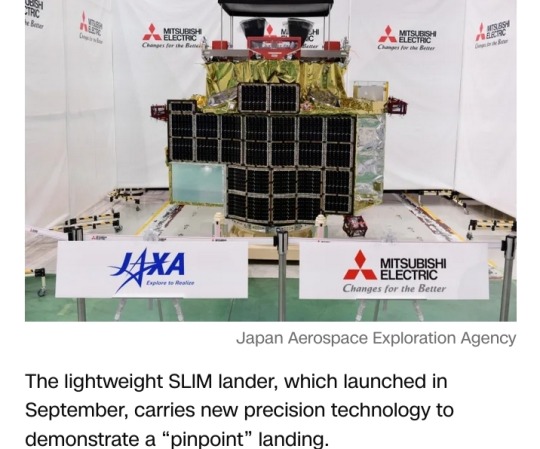
The small-scale SLIM robotic explorer, which launched in September, goes by the nickname “Moon Sniper” because it carried new precision technology to demonstrate a “pinpoint” landing.
Previous lunar missions have been able to target and reach specific zones that spanned many kilometers, but the SLIM lander targeted a landing site that stretches just 100 meters (328 feet) across.
The lander’s “smart eyes” — an image-matching-based navigation technology — rapidly photographed the sloped lunar surface on approach and autonomously made adjustments as the spacecraft descended toward touchdown.
The JAXA team is still working to determine the accuracy of SLIM’s landing, which could take up to a month.
Moon Sniper’s journey
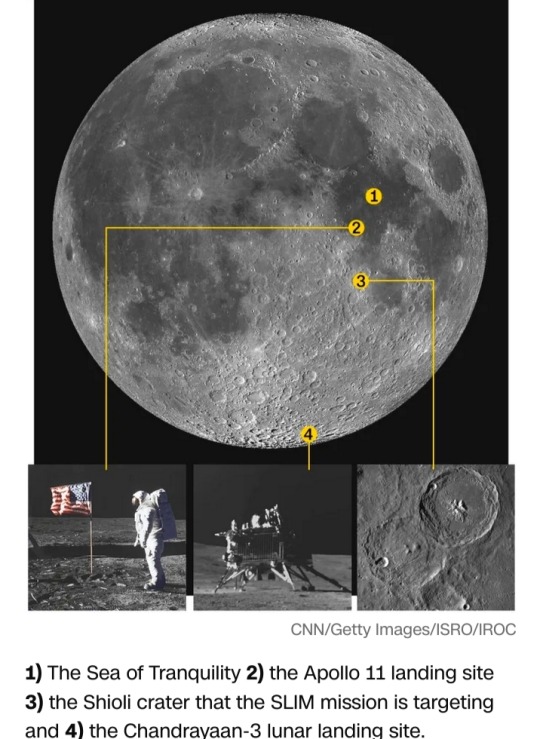
The Moon Sniper targeted a landing site near the small Shioli crater within a lunar plain called the Sea of Nectar that was created by ancient volcanic activity and lies just south of the Sea of Tranquility, where Apollo 11 landed in 1969.
The lander is designed to briefly study rocks at the site that could reveal insights into the moon’s origin.
When meteorites and other objects strike the moon, they create craters as well as rocky debris that litters the surface.
These rocks intrigue scientists because studying them is effectively like peering inside the moon itself.
Minerals and other aspects of the rocks’ composition can potentially shed more light on how the moon formed.
Landing near the sloped, rock-strewn areas around craters is a hazardous process that most missions usually avoid, but JAXA believes its lander has the technology to touch down safely on rocky terrain.
New space race

Multiple space agencies and countries have attempted moon landing missions over the past year, leading to a historic first as well as failures.
India became the fourth country — after the United States, the former Soviet Union and China — to execute a controlled landing on the moon when its Chandrayaan-3 mission arrived near the lunar south pole in August.
Meanwhile, Japanese company Ispace’s Hakuto-R lunar lander fell 3 miles (4.8 kilometers) before crashing into the moon during a landing attempt in April.
Russia’s Luna-25 also crash-landed in August during the country’s first attempt to return to the moon since the Soviet Union’s fall.
Astrobotic Technology’s Peregrine spacecraft — the first US lunar lander to launch in five decades — met a fiery end Thursday after a critical fuel leak made safely landing on the moon out of the question.
Part of the motivation behind the new lunar space race is a desire to access water trapped as ice in permanently shadowed regions at the lunar south pole.
It could be used for drinking water or fuel as humanity pushes the bounds of space exploration in the future.
This region is riddled with craters and strewn with rocks, leading to narrow landing sites.
The lightweight SLIM lander might be an effective design that could not only land in small areas of interest on the moon but also on planets such as Mars, according to JAXA.

#Moon Sniper#robotic explorer#moon#Japan Aerospace Exploration Agency#Japan#Smart Lander for Investigating Moon#SLIM#Dr. Hitoshi Kuninaka#LEV-1#LEV-2#lunar rovers#Sea of Nectar#Sea of Tranquility#Chandrayaan-3#Hakuto-R#Luna-25#Peregrine spacecraft#JAXA#space#space agencies
0 notes
Text
Japanese Company’s Moon Lander Is Presumed Lost After Going Silent
A lunar lander built and operated by ispace, a Japanese startup, descended to the surface of the moon today after a months-long journey — but went out of contact and was presumed lost.“We have to assume that we could not complete the landing on the lunar surface,” ispace CEO Takeshi Hakamada said during a webcast of the Hakuto-R mission’s final stages.Ground controllers at the Hakuto-R Mission…

View On WordPress
0 notes
Text
Moments before dying, Japan's lunar lander snaps glorious photo of Earth during a total solar eclipse | Live Science
0 notes
Text
Moments before dying, Japan's lunar lander snaps glorious photo of Earth during a total solar eclipse | Live Science
0 notes
Text
Moments before dying, Japan's lunar lander snaps glorious photo of Earth during a total solar eclipse | Live Science
0 notes